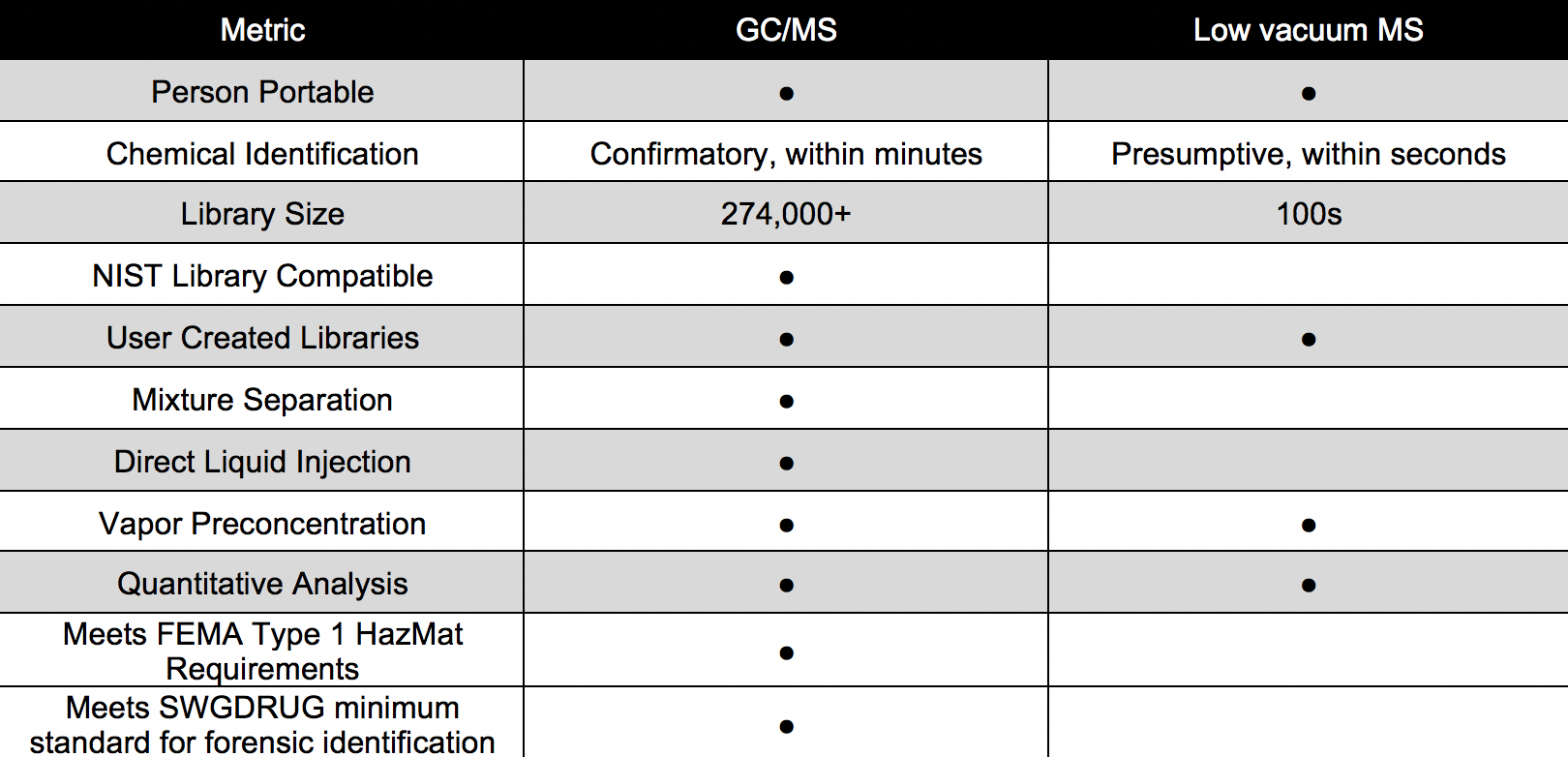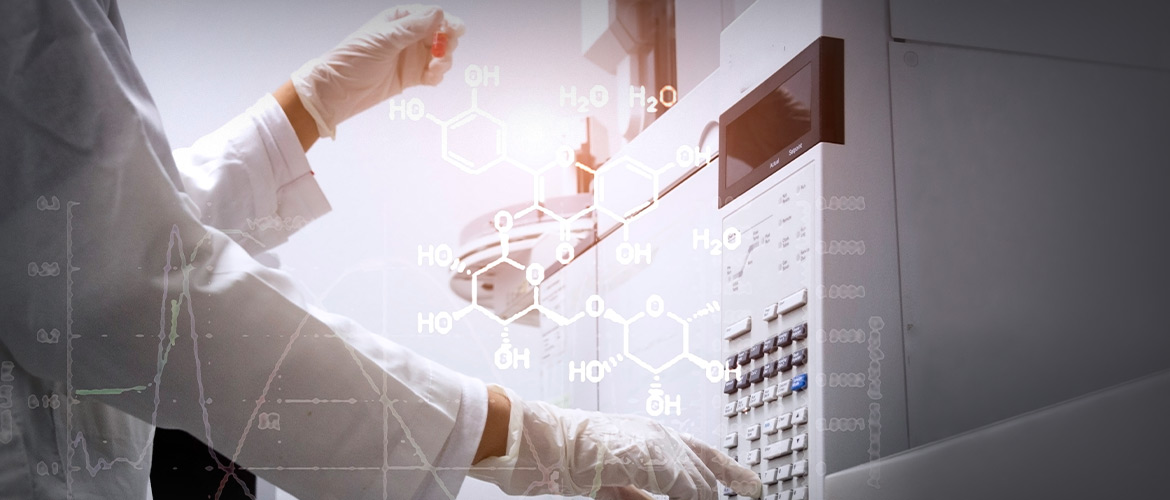
Understanding the difference between portable GC/MS and low vacuum MS technologies
Mass spectrometry is mass spectrometry, right? Not exactly. Scientifically speaking, mass spectrometry (MS) is an analytical technique that uses the weight of individual chemical molecules and their fragments to identify an unknown sample. In the field, mass spectrometry has become an umbrella term for a wide range of analytical instruments, with applications ranging from health sciences and pharmaceutical research in a laboratory setting, to forensic science, environmental monitoring, military reconnaissance, and hazardous materials (HazMat) response teams doing field work (figure 1). Field-based missions can be very different, and so can mass spectrometry techniques.
The most common MS techniques used by elite responders in the field are gas chromatography mass spectrometry (GC/MS) and low vacuum mass spectrometry (MS). Frequently they can be used together, but they are not interchangeable. To ensure the right tool is selected for the job, each technique and its capability must be considered in its entirety.
Download Whitepaper Request Quote
Select the right tool based on mission requirements
-
DO YOU NEED A SYSTEM THAT CAN BREAK DOWN COMPLEX MIXTURES?
If the answer is yes, GC/MS is the right tool for the job. GC/MS has a long history of being the undisputed laboratory gold standard for chemical identification and quantification. It combines an upfront gas chromatography (GC) separation stage with the analytical capabilities of mass spectrometry (MS) to breakdown complex mixtures and identify with certainty each individual component in the sample. The orthogonal nature of the technique means that identification is based on both the mass spectra (chemical fingerprint) and the retention time (an indication of the travel time through the GC component).
GC-based separation of complex mixtures permits the isolation of background matrix, fillers, cutting agents, and precursors that may obscure the detection of the critical minority component. Just as important, these secondary materials may provide the required forensic information to track the material back to its source. Without a GC separation, low vacuum MS is challenged with the detection, identification, and ultimately quantitation of complex sample mixtures, or those with a key minority component. Chromatographic and mass spectral data produced using lab-based GC/MS has been widely admitted as evidence in court as the bottom line in sample identification. GC/MS satisfies the SWGDRUG minimum standard for identification. Low vacuum MS alone does not satisfy the SWGDRUG recommendations to meet the standards of identification (see “Did you know?” and Table 1 below).


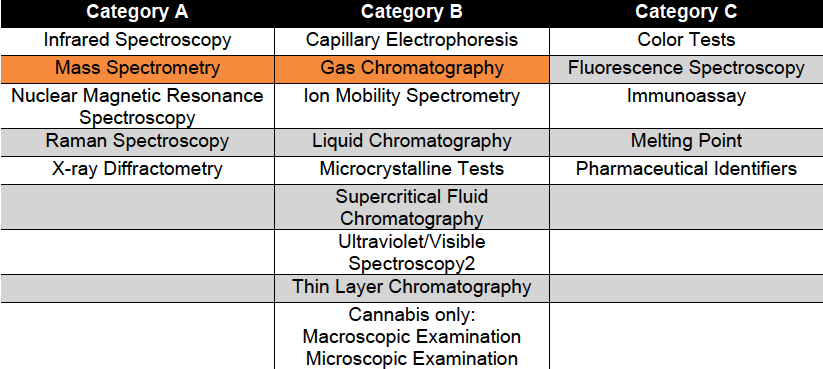
Table 1 – Analytical Technique Categories
-
HOW MANY CHEMICAL TARGETS DO YOU NEED TO IDENTIFY?
If your mission is to address unknowns, GC/MS is the right tool for you. If you have a smaller, pre-defined list of chemicals of interest, low vacuum MS, GC/MS, or a combination of the two could be right for the mission. That will depend on additional factors like speed of results and intended action based on the results.
The sensitivity and resolution gained by separating the sample into individual components and comparing against a broad library, such as the NIST/EPA/NIH Mass Spectral Library which contains over 274,000 chemical mass spectra, is what makes GC/MS the most powerful technique available for confirmatory sample identification. Especially when identifying unknowns. Figure 2 shows separation and identification of three chemicals in a single analytical run on a portable GC/MS instrument. Figure 3 is an example of a mass spectra, or unique chemical fingerprint, for a single chemical within a mixture. Without mixture separation, low vacuum MS requires the development of a custom library specific to a hardware configuration. These lower fidelity spectra in a custom library cannot be compared to the industry standard NIST library of mass spectra. While a small focused library is useful in presumptive screening missions, it is limited in how many targets it can detect and may be insufficient for complex mixture or unknown analysis.
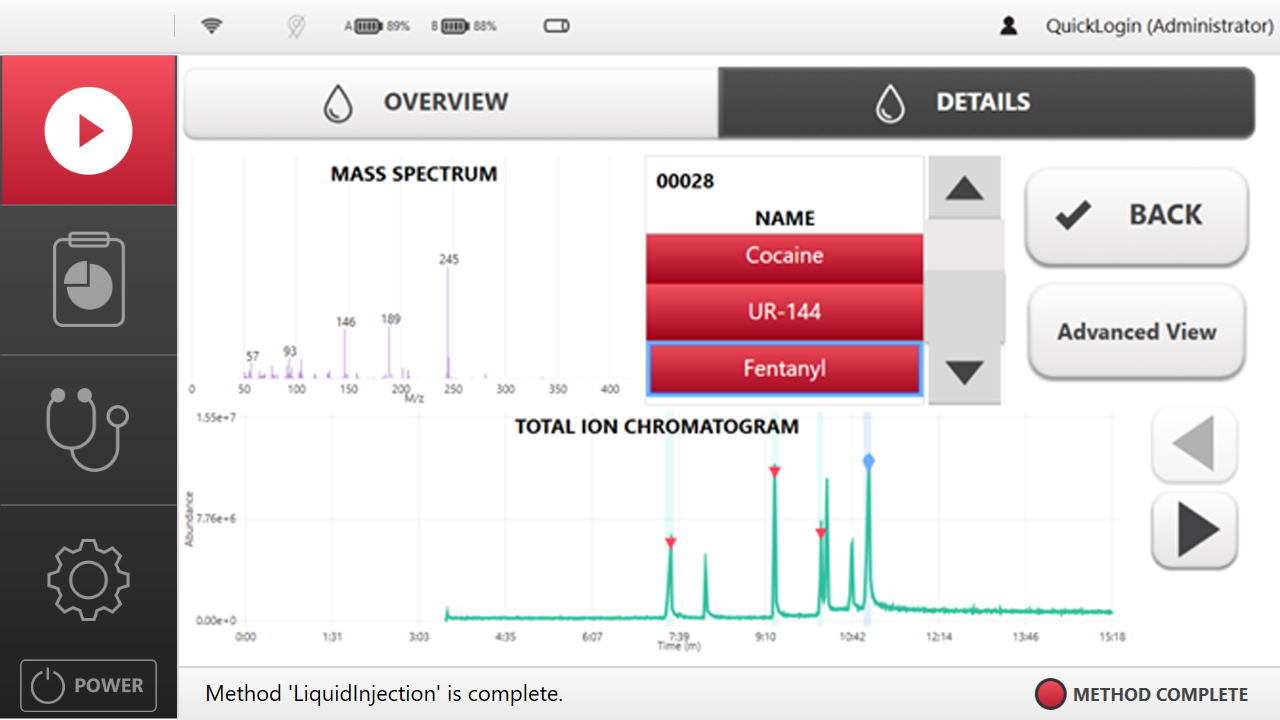
Figure 2 - Mixture separation via portable GC/MS
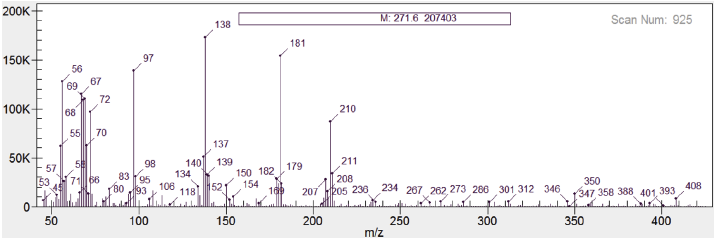
Figure 3 - Mass spectral results for FGA A232 after a full GC/MS analysis
-
HOW FAST DO YOU NEED AN ANSWER?
To shorten the analysis time, low vacuum MS does not typically have a GC separation stage. This enables the low vacuum MS system to produce a faster result, often in seconds. Low vacuum MS technology is primarily used as a presumptive identification tool. It is used to establish what a substance is not and delivers a presumed identity of a threat material based on a limited data set. Equipment that provides presumptive identification helps field users perform initial scene size-up and determine response tactics. It may not be definitive enough for further action.
Analysis time via GC/MS is often measured in minutes, with the largest time component being the GC separation at the front end of the analysis. While larger, lab-based systems complete an optimized chemical analysis in sixty minutes or longer, field-portable GC/MS instruments can usually produce comparable, confirmatory results in as little as ten minutes due to the more compact nature of the low thermal mass GC (LTMGC) design. Confirmatory identification is based on high-fidelity principles that help field users know the extent or impact of hazard, inform remediation actions, or trace the sample back to the source.


-
DO YOU NEED A PRESUMPTIVE ANSWER, TO TRACE SAMPLE BACK TO THE SOURCE, OR A CONFIRMATORY RESULT?
It is important to remember what your end goal is. What will you do with the results delivered to you? Resolution is a critical technical consideration when deciding which tool to use for the mission at hand. The two technologies can be used in combination during a mission – start with screening (low vacuum MS) and end with confirmation (GC/MS).
Traditional MS takes place in a vacuum chamber because individual molecules and their ionized fragments need to move freely in a space without the risk of collision with air (oxygen and nitrogen) or other gas molecules. The resolution of the mass spectra is thus highly dependent upon the mean free path of those fragments and their ability to move freely. To utilize industry-standard, third-party libraries, such as the NIST/EPA/NIH Mass Spectral Library, for matching and confirmation, the resolution must not exceed 0.7 full width half maximum (FWHM). This is known as 1 atomic mass unit (amu), which is considered the laboratory standard of resolution and ensures mass peaks in a chemical fingerprint do not overlap. Overlapping mass spectra can cause uncertainty in the field, and in a worst-case scenario, misidentification. GC/MS offers FWHM resolution and accuracy.
Low vacuum mass spectrometry is a recent addition to the field of MS. In low vacuum MS, the mass analyzer is not held at high vacuum, instead bathed with an inert buffer gas, which simplifies the design and reduces the size, weight, and power requirements. The simplification comes at the cost of resolution on the mass analyzer, with FWHM values in the range of 0.9-1.4, meaning loss of baseline resolution and overlapping peaks in the spectrum. Low vacuum typically translates into low-resolution spectra, largely due to the high, or almost ambient pressure it operates under compared to GC/MS, which operates under extremely low pressure. Without FWHM resolution or mixture separation, low vacuum MS requires the development of a custom library specific to a hardware configuration. These spectra cannot be compared to industry standard libraries specifically including NIST. Resolution also deteriorates as the m/z (fragment size) reduces and low vacuum MS will be expected to experience air interference in the m/z >45 amu range.
Figure 4 compares a NIST mass spectrum compatible with GC/MS to a spectral result from low vacuum MS. The NIST spectrum produces a clearly defined chemical fingerprint, while the low vacuum MS results are less clean. The low vacuum MS results require custom library algorithms to interpret the data. For these reasons, low vacuum MS is the good tool for rapid scene size-up and follow-on response tactics. GC/MS is the tool of choice when the end goal is confirmation, remediation, or tracking the sample back to the source. The technologies work together to complete a mission.
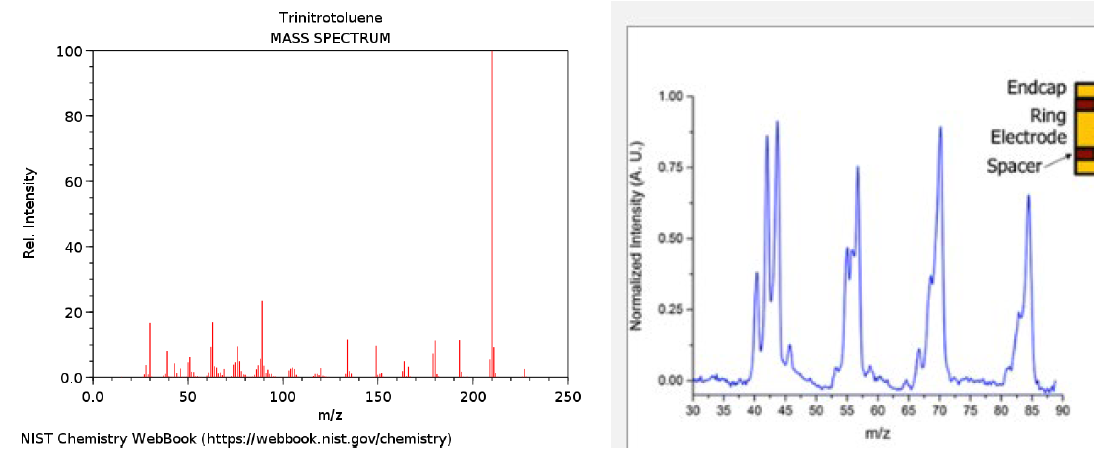
Figure 4 - Resolution comparison of NIST MS spectrum (left) compatible with GC/MS, versus the broader peaks of HPMS (right) necessitating a custom library algorithm


-
WHAT SAMPLE PHASE DO YOU NEED TO ANALYZE – LIQUID, SOLID, VAPOR?
Laboratory-based GC/MS instruments can readily analyze samples in the gas, liquid, or solid phases. Some older generation field-portable units are limited to vapor only, a result of their pumping capability to maintain the necessary vacuum. Smaller, more efficient vacuum pumps have been introduced in next generation portable GC/MS systems and have demonstrated the capability to match analytical performance previously limited to fixed-site technology. In short, the vacuum system determines what sample phases can be analyzed by MS.
A mass spectrometer is capable of sensitive trace analysis, meaning levels the human eye cannot see. Managing sample loading ensures the optimal result of detectable samples without overloading the detector. New generation portable GC/MS systems are offered with the same split/splitless injection port found previously in lab-based GC/MS systems. A fully integrated injector facilitates the introduction of prepared, liquid-based samples. Contaminated surface swabs, explosive residue, illicit powders samples, and seized tablets and pills can all be dissolved in a simple solvent matrix and diluted as necessary. The split/splitless injection also supports a range of GC/MS methods that can analyze all or just part of a sample introduction, further supporting the dynamic range of the instrument.
Low vacuum MS systems produce data quality comparative to ion mobility spectroscopy (IMS), Fourier transform infrared (FTIR), or Raman spectroscopy, which provides users with a presumptive identification from a targeted library of known and predicted threats. Samples may be introduced through direct vapor analysis or liquid/solid matrices delivered on a swipe. Care must be taken to prevent overloading the sample inlet, since the dynamic range of low vacuum MS systems is not as broad as GC/MS instruments. Concentrated samples should be “diluted” through a series of swipe-to-swipe transfers, an effective technique, but one which comes at the cost of increased consumables use.
CONCLUSION
GC/MS and low vacuum MS techniques complement one another in field-based chemical identification applications, but one does not replace the other. The strengths of low vacuum MS lie in fast presumptive results against a known, targeted threat list. It can be packaged in a small, light form factor. Field-portable GC/MS systems deliver comprehensive, confirmatory results from a library of over 270,000 chemicals in minutes and satisfies the equipment requirements for Federal Emergency Management Agency (FEMA) Type 1 Hazardous Materials teams and the SWGDRUG minimum standards for the forensic identification of commonly seized drugs.

